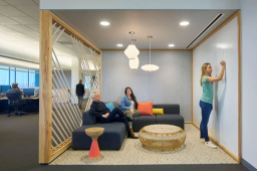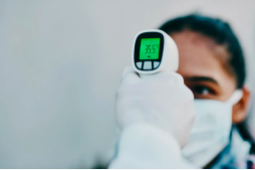1. Collaboration Is the New Work Model
Everybody has heard a story about an R&D company that started out as four people in the garage sitting around with folding chairs and tables. There was energy, a buzz. Something was happening. As the company grew bigger, it moved into larger, more-traditional office space. Employees ended up getting private offices with windows, but something happened — they lost the energy.
Essentially, every company reaches a point in its organizational maturity where it loses the original buzz. But when an R&D team goes into a space that similarly affects what it does, it will impact the output. Why not provide a space that is more collaborative and supports the need to balance both think time and team time?


2. Say Goodbye to Big Private Offices
Imagine an alternative work environment in which each team member has a smaller workstation, but all the workstations are put into a wagon train formation. Instead of having a conference room down the hall, the conference room is in the middle of the workstations. The team members are just close enough to overhear each other and they’re buzzing with project ideas in each station and in the middle space. When privacy is needed, the smaller workstation offers a door.

3. Say Hello to Shared Private Enclaves
By applying some basic, simple knowledge about how people interact, space planning can restore that feeling of the entrepreneurial garage without sacrificing privacy. For instance, instead of everyone having an 8-by-9-foot workstation, what if they were designed as 8-by-8-foot stations? The saved 1-by-8-foot strips could be put together to create a pint-sized enclave with a door with two pieces of lounge furniture, a table, a laptop connection, and a phone connection that is shared among five people.
That’s where team members go when they need time to look through notes, write notes, or do research on their laptop computers. To make private phone calls, employees move 20 feet out of their stations into this private space, shut the door, and call. That privacy doesn’t exist in the way buildings are built today. Employees moved out of offices into open plans, but they never got back the privacy that they lost.


4. Management Must Rethink Technologies
A shift in technologies has to happen, too: Laptops and cordless phones have disconnected the worker from having to be in one place all the time. Designing for the organization also must be rethought. If something is not within 10 to 15 feet of the employee looking for it, it’s not useful. Immediate files must be separated from long-term files.
As an extreme, for an alternative work environment really to work, it takes a management team to say, “This is what we will be doing and I’m going to lead by example. I’m going to move out of my office, put my files in central storage, keep my immediate files with me, and untether myself with technology.” If a company is not ready to do that, then its plan should be much more traditional. However, competitive pressures and rising real estate costs are forcing many to rethink how they provide space.








